vanepico
|
| posted on 1/7/12 at 01:03 AM |

|
|
Towing A Frame Concept
As you may or may not now I'm gonna be on my work placement soon, where I'm going to be drafting parts in cad so I thought I'd do a
project or something
 
Description
As the ones on the market are pretty expensive I thought I would have a go at designing my own, using the strength of 8.8 bolts to remove my crummy
welding from the equation. 
I noticed most of the current ones on the market do not have braking systems which means you legally cannot tow a vehicle that is greater than
750kg.
 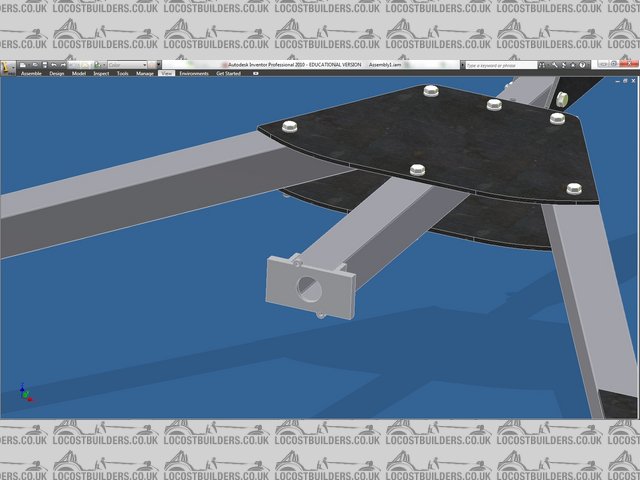
Description
So I've made a part for a miscellaneous car master cylinder which is actuated by an over-run system like a caravan. It would either be plumbed
to an actuator pressing the pedal, or if the car is knackered you could plumb it straight to the braking system.
 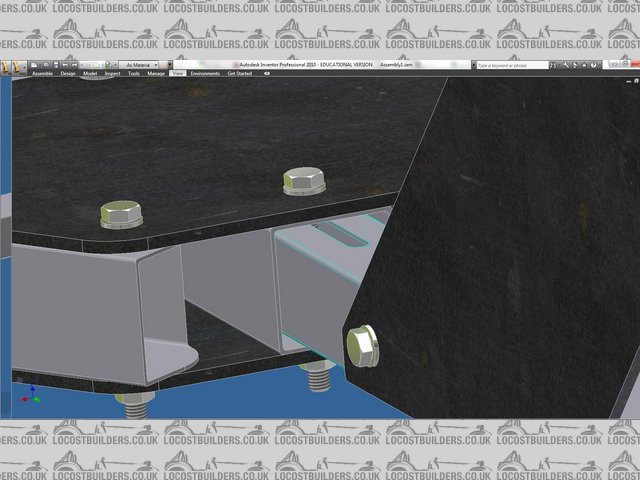
Description
In between the two sliding RHS there will be 3mm ptfe sheets to lubricate it. (oooeer!)
 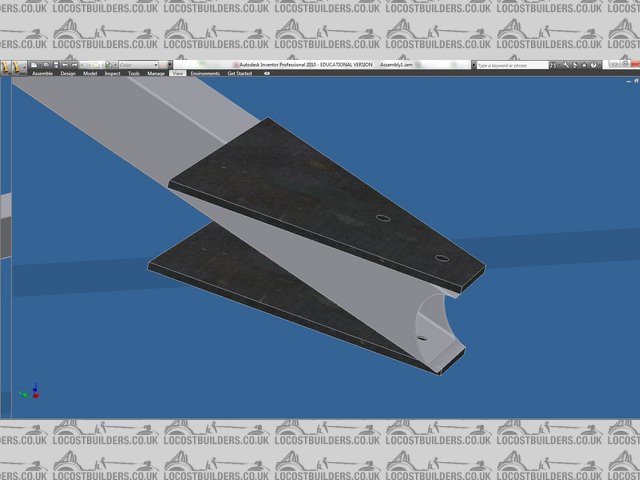
Description
The front wishbone of the car is pushed into the groove and a ratchet strap is mounted onto the flat plate which loops over the edge.
I've calculated the loads and even with a factor of safety of 5 and a car with a 0-60 rating of 5 seconds, on a 10 degree uphill gradient,
pulling a 1500kg car, you only need 176.6mm^2 of mild steel with a UTS of 300MPa. Negating any shock loads or side loadings.
It is only a prototype at the moment, the only problem I can see at the moment is it probably needs the bumper of the car removing as the wishbones
are normally behind it.
So on the DVLA website it points out that as soon as an a frame is attached to a car it ceases to be a car and becomes a trailer, and it implies that
the car being towed does not need to be taxed or MOTed, just needs to be lit properly, with the tow cars number plate visible, and not likely to fall
apart on the road!
I was looking into this as it would greatly ease the sourcing and transportation of a kit car donor  . Apparently a 1128kg ford sierra is no match
for a diesel ford galaxy . Apparently a 1128kg ford sierra is no match
for a diesel ford galaxy 
Pete
|
|
|
|
|
owelly
|
| posted on 1/7/12 at 06:10 AM |

|
|
The problem with using the towed car brakes, actuated by over-run on the A-frame drawbar, is they are not 'trailer specific' and as such,
can't be considered as trailer brakes. It is for this reason that A-frames, braked or un-braked, are for 'recovery to a safe place
only'.
http://www.ppcmag.co.uk
|
|
|
vanepico
|
| posted on 1/7/12 at 07:02 AM |

|
|
This is not what the DVLA website says, it says the use of dollies (two trailer wheels) is for recovery.
"If you attach an A-frame to a car in order to tow it with a larger vehicle, the car plus A-frame counts as a trailer."
If you don't use the car brakes, there are no other wheels you can use!
People who have motorhomes have been towing smart cars legally for years, I find it hard to believe that in every single case of someone towing one,
not one traffic cop would have stopped them.
The dolly counts as a trailer towing a trailer.
"If you use a dolly to tow a broken-down vehicle, the dolly counts as a trailer."
|
|
|
Ben_Copeland
|
| posted on 1/7/12 at 07:03 AM |

|
|
Plus the towed car must be road legal, tax mot and insurance unless its going to an mot garage for work then it only needs insurance
Ben
Locost Map on Google Maps
Z20LET Astra Turbo, into a Haynes
Roadster
Enter Your Details Here
http://www.facebook.com/EquinoxProducts for all your bodywork needs!
|
|
|
Ben_Copeland
|
| posted on 1/7/12 at 07:09 AM |

|
|
Going back to your design. I have a Aframe at home so can compare. Your legs going to the wishbones need to be much longer (depends how accurate you
meant the drawing to be) also you dont want to use ratchet straps over the wishbones as they will get worn through. Chains that pull tight over the
wishbone which are then attached to the ratchet straps for tightening.
Ben
Locost Map on Google Maps
Z20LET Astra Turbo, into a Haynes
Roadster
Enter Your Details Here
http://www.facebook.com/EquinoxProducts for all your bodywork needs!
|
|
|
owelly
|
| posted on 1/7/12 at 07:18 AM |

|
|
Pete, I've been there, seen it, invested time, money and effort and had no money left to buy the tee-shirt. I see dozens of off-roaders on
A-frames attending an off-road course up the road from me, and dozens of little cars behind campers at the campsites. I've also seen thousands
of cars pass me at well over 70mph on the motorway but that doesn't make it legal.
If you're saying the towed car is now a trailer, it has to have trailer specific brakes.
http://www.ppcmag.co.uk
|
|
|
vanepico
|
| posted on 1/7/12 at 07:34 AM |

|
|
It clearly says on the website that a vehicle with an A Frame BECOMES a trailer, nowhere does it say it has to be MOTd or taxed, trailers do not need
MOTs or tax.
|
|
|
Slimy38
|
| posted on 1/7/12 at 07:51 AM |

|
|
This site has a bit of a summary regarding legalities;
http://www.smart-tow.com/legal.htm
It's also interesting to see what they did for the overrun braking method, which is what you're aiming for?
I've also seen some suggestions that reversing can be difficult, I guess that triggers the overrun brakes? It's something to
consider...
[Edited on 1/7/12 by Slimy38]
|
|
|
907
|
| posted on 1/7/12 at 08:10 AM |

|
|
Hi Pete.
It's just my opinion, but I would question the use of bolts as opposed to a fully welded construction.
The winch for my trailer came with a "top hat" mount so I made a cross member to bolt it to.
As I didn't want to mess up the galvanized chassis I bolted the cross member to the chassis.
I folded the front & back edges of the 2.5 mm galv sheet to stiffen it, and used M8 8.8 bolts to fix it on.
As you can see in the second close up pic the sheet has bent. Now it's not going to fail completely
but it does show the limits of bolting flat sheet to a box. Had I not folded the edges the result
would have been much worse.
Cheers
Paul G
 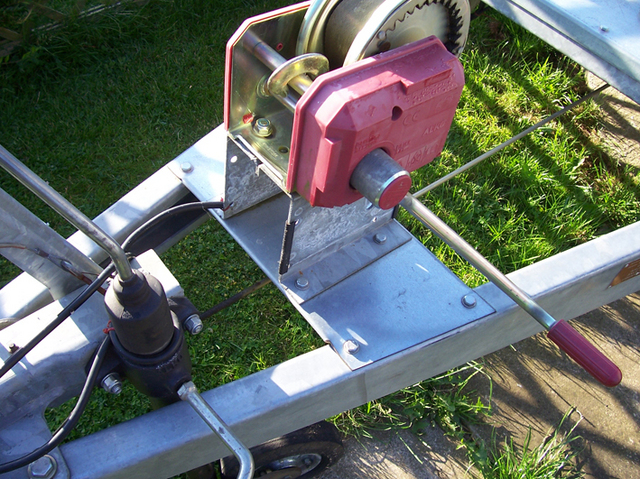
winch mount
 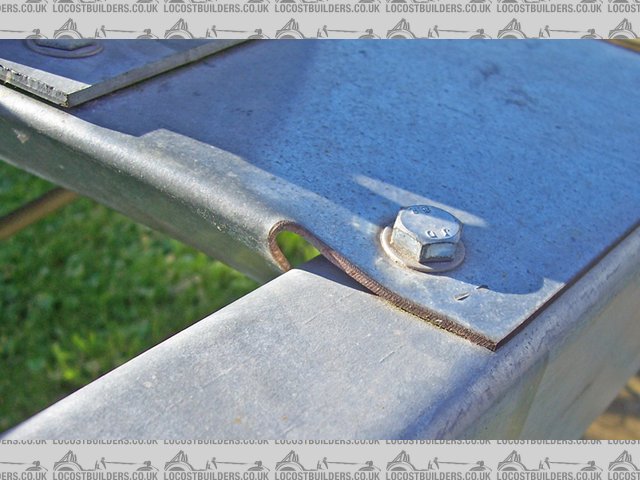
winch mount. bent sheet
|
|
|
cliftyhanger
|
| posted on 1/7/12 at 08:21 AM |

|
|
Have I missed something, because I cannot see an easy way of connecting the a-frame brakes to the towed car brakes.
Unless you are considering one of the clever mocal connectors, and having the car set up to be connected (ie a dedicated a frame/car setup)
|
|
|
owelly
|
| posted on 1/7/12 at 08:41 AM |

|
|
quote:
Any braked trailers manufactured after April 1989 must be fitted with a hydraulically damped coupling and auto reverse brakes to give braking
efficiencies required by EEC Directive 71/320 (ECE13).
Normal car brakes do not have any auto reverse capabilities. And the Directive also mentions the effects of any servo/power assistance when
calculating efficiencies.
http://www.ppcmag.co.uk
|
|
|
AndyW
|
| posted on 1/7/12 at 08:47 AM |

|
|
This is an interesting one. I see regularly, motorhomes towing a small car behind on what looks like an A frame. So there must be some kind of legal
way to tow a car using a frame design?
Maybe the motor home manufacturers know of a product that does this safely and legally??
Just a thought.
|
|
|
owelly
|
| posted on 1/7/12 at 09:00 AM |

|
|
Long story short......
It's not legal but the BiB, courts, VOSA and DVLA can't pick the bones out of the legislation, so no-one says anything. There will be a
point where a case goes to court and a precident will be set, but until then.......
I spent months chasing the various authorities for answers and got the definitive answer but it involves trawling dozens of EEC Directives, which have
very little to do with any UK application but makes up the legal mess you need to navigate to get an answer.
In short:
If any of the towed vehicle wheels are touching the road, it has to be fully road legal.
If the towed vehicle weighs over 750kg OR has brakes fitted, they have to be trailer specific brakes (ie damped and auto reverse). So even if your
little car weighs less than 750kg but has brakes, as all cars do, they have to be trailer specific...
There are regulations apertaining to the towed vehicle brakes being directly coupled to the integral braking system of the towed vehicle(not just
acting on the brake pedal) but the brakes still need to be trailer specific but negates the need for the servo/power assistance to be working.
http://www.ppcmag.co.uk
|
|
|
balidey
|
| posted on 1/7/12 at 09:02 AM |

|
|
Grey area.
I've heard all sides of this argument.
My brother in law has been pulled literally dozens of times. Traffic cops usually say as its not for recovery he's not allow to carry on with
his journey.
Not once has anyone taken it further. No prohibition notices, no convictions and when asked directly what the law states on the subject, not one
reply.
This has been going on with him for years.
He has had a couple of producers and there was a law stated on it about why they have stopped him. I investigated it to find the law that he had
broken. Turns out that the law the traffic officer has stated was actually just the law that says they are allowed to stop him.
I think the biggest problem is that most people who say they are illegal quote the 'the car becomes a trailer'. That is utter crap. If it
'becomes' a trailer then everything about the towed car HAS to meet trailer regulations, which are as complicated as with a car.
The truth is, the law as it stands does not fully cover it and does not give a definite answer what is legal or not.
The ONLY people who can define this is a judge.
I work in a profession where I have to build vehicles to Construction and Use regs. There are numerous books that interpret the law, but not one of
them can be used legally as they INTERPRET the law. eg, if the law says a flashing light on a car is an indicator, can I interpret that as a flashing
brake light is an indicator? NO. But a judge CAN interpret it like that. It doesn't change the law. And laws can take years to get amended.
The ONLY way for this to be resolved is for the law to change.
Until then no one can say they are or aren't legal.
As for the OP's project.
I too like to make things, but this is a safety critical item. I would not be happy making a towing dolley. You could design it to pull the weight of
the car, but what G loads are you going to put in? What FOS are you going to use? If you have an accident you would be in major trouble. My brother in
law had one of his chains snap on his a frame whilst towing. He managed to explain that there must have been a defect in the chain link, but if it had
been a home made A frame then I'm sure he would not have got away with it.
Seriously, £200 is not a lot to spend in one.
Dutch bears have terrible skin due to their clogged paws
|
|
|
designer
|
| posted on 1/7/12 at 10:09 AM |

|
|
Surely it would be better to do a project on something else, rather than a piece of equipment in such a 'grey' area.
Also, as said, using bolt construction means you have to use thicker materials, thereby increasing weight on a product where weight is very important
due to the 'unbraked' trailer rules.
And, you can buy A-frames for next to nothing!
[Edited on 1-7-12 by designer]
|
|
|
matt_claydon
|
| posted on 1/7/12 at 10:33 AM |

|
|
This is the official interpretation from the DfT. As above, its an interpretation, not law as such, but being from central government it's as
close as you're going to get:
http://assets.dft.gov.uk/publications/dft-information-sheets/a-frames-and-dollies.pdf
|
|
|
owelly
|
| posted on 1/7/12 at 11:47 AM |

|
|
Yes, as said, that's an interpretation and it references:
"Regulations 15 and 16 of C&U set out the braking requirements - including minimum braking efficiencies for trailer brakes. Subject to
certain age exemptions, the regulation requires the braking system to comply with the construction, fitting and performance requirements of European
Community Directive 71/320/EEC along with its various amending Directives. Alternatively the braking system can comply with the corresponding UNECE
Regulation No.13.09."
Which is where things get squirrelly.......
http://www.ppcmag.co.uk
|
|
|
coyoteboy
|
| posted on 1/7/12 at 12:08 PM |

|
|
Isn't it easier to make a caravan chassis trailer? For a weekend car I'd seriously consider storing it ON the trailer to save space and
just ensure it's secure but I'm not sure about the legal ramifications of that - it could be that the theft insurance is invalid when on a
trailer.
|
|
|
redscamp
|
| posted on 1/7/12 at 02:46 PM |

|
|
ignoring the legal side,i have towed with an a frame once (sierra pulled by sierra p100)
before you ask i did release the steering lock on the towed vehicle.
it took a lot of steering effort to turn and the same again to staighten up.
i stronghly recomend you dont use an a frame (at least for similar sized vehicles)
ive also used a "spectacle trailer" and found it much easier to live with
|
|
|
vanepico
|
| posted on 1/7/12 at 02:52 PM |

|
|
quote:
Originally posted by 907
Hi Pete.
It's just my opinion, but I would question the use of bolts as opposed to a fully welded construction.
The winch for my trailer came with a "top hat" mount so I made a cross member to bolt it to.
As I didn't want to mess up the galvanized chassis I bolted the cross member to the chassis.
I folded the front & back edges of the 2.5 mm galv sheet to stiffen it, and used M8 8.8 bolts to fix it on.
As you can see in the second close up pic the sheet has bent. Now it's not going to fail completely
but it does show the limits of bolting flat sheet to a box. Had I not folded the edges the result
would have been much worse.
Cheers
Paul G
 
winch mount
 
winch mount. bent sheet
I'm not surprised that bent, 2.5mm sheet with that large leverage. It is all about the second moment of area of the beam, a 2.5mm sheet has
barely any. That has nothing to do with bolted connections, that would have happened if you welded it or not.
The shear strength of an 8.8 M8 bolt is well over 10000 newtons
[Edited on 1/7/12 by vanepico]
|
|
|
coyoteboy
|
| posted on 1/7/12 at 02:56 PM |

|
|
Got to agree with you on that one - that sheet was not up to the job.
To me the legality side of this is the only issue I have with an otherwise interesting sounding project. Personally I'd spend my time designing
a 7-capable trailer following the principles of the locost.
|
|
|
vanepico
|
| posted on 1/7/12 at 08:48 PM |

|
|
quote:
Originally posted by owelly
quote:
Any braked trailers manufactured after April 1989 must be fitted with a hydraulically damped coupling and auto reverse brakes to give braking
efficiencies required by EEC Directive 71/320 (ECE13).
Normal car brakes do not have any auto reverse capabilities. And the Directive also mentions the effects of any servo/power assistance when
calculating efficiencies.
Of course they don't, because when you want to reverse a car, you take your foot off the pedal! This can be sorted by taking a signal from the
reverse light cable and linking it up to an actuator which holds the over-run system outstretched, its a minor technicality!
|
|
|
vanepico
|
| posted on 1/7/12 at 09:01 PM |

|
|
quote:
Originally posted by owelly
If the towed vehicle weighs over 750kg OR has brakes fitted, they have to be trailer specific brakes (ie damped and auto-reverse)
I think you'l find the damper has nothing to do with the brakes, it is a side to side damper to reduce tank slapper effects from trailers. It is
either a steel spring coming out of the side of the tow bar mount on the car, going into a rubber part mounted on the trailer, it could also be, like
our family caravan, where two rubber plates are clamped either side of the tow ball.
The auto reverse braking system is a formality which can be solved easily, I don't see what makes the crummy trailer drum brakes alright and the
hi tech discs of a car not.
|
|
|
owelly
|
| posted on 1/7/12 at 09:09 PM |

|
|
And I think you'll find that the damper is in the coupling and has nothing to do with any anti-snaking device. It's there to help with the
effects of harsh braking causing the trailer brakes to lock-up.
The regs state what sort of brakes you need to have. Saying you can make the 'trailers' brakes work in the same way doesn't change
what the rules say. It's a bit like saying "I know I can't tow an unbraked trailer that weighs more than 750kg, but I've
attached -50kgs worth of helium ballons to it so it can weigh 800kg..."
But, if you think you have got it all in hand, good luck with the project.
http://www.ppcmag.co.uk
|
|
|
matt_claydon
|
| posted on 2/7/12 at 09:07 AM |

|
|
The damper is required as part of the 'compatibility' requirements for the braking system. With inertia overrun systems brakes are
actuated by the trailer pushing against the car when the car starts to decelerate (obviously!), once the trailer brakes come on the pushing then
reduces, this cause the trailer brakes to release and then the trailer wil start pushing the car again. The damper prevents this undesirable
'resonance', and as Owelly says, also prebents the trailer brakes coming on too hard at the initiation of harsh braking. There are
calculations to define the damping required.
For related reasons, there are complicated compatibility calculations which define how much brake torque at the wheels should be given for a given
force on the coupling head.
In theory you can obviously do the calculations to meet the above, and you can engineer an auto-reverse system, but there is one big sticking point.
ECE Regulation 13 states:
quote:
5.2.2.2. Trailers of category O2 must be equipped with a service braking system either of the continuous or semi-continuous or the inertia (overrun)
type. The latter type shall be permitted only for centre-axle trailers. However, electrical braking systems conforming to the requirements of
Annex 14 to this Regulation shall be permitted.
(An O2 trailer is one between 750kg and 3500kg). Note, centre-axle allows any number of axles, but the must be grouped at approximately the CoG of the
vehicle.
A car is NOT centre-axle, and so an inertia overrun system is never acceptable.
[Edited on 2/7/12 by matt_claydon]
|
|
|













